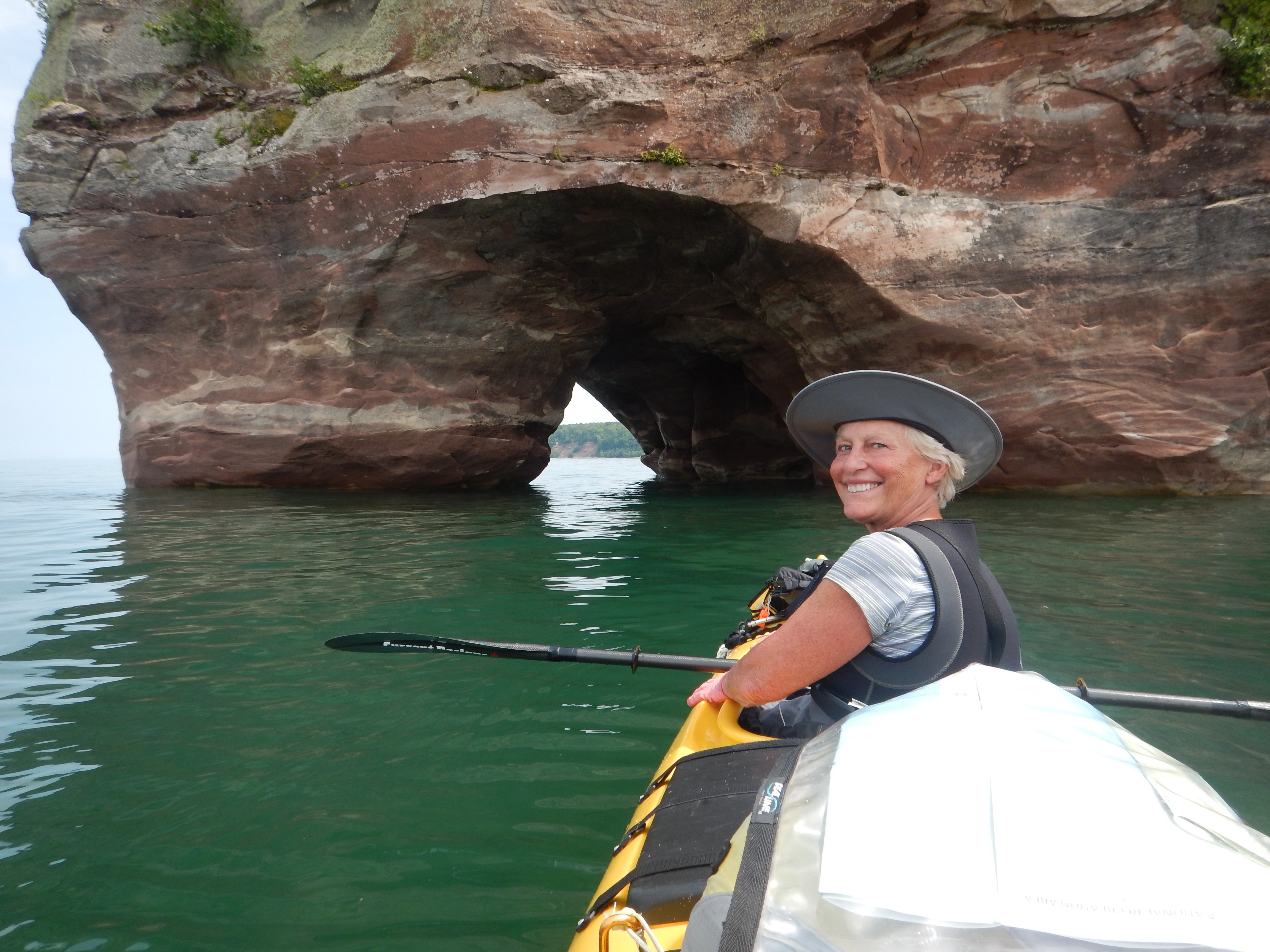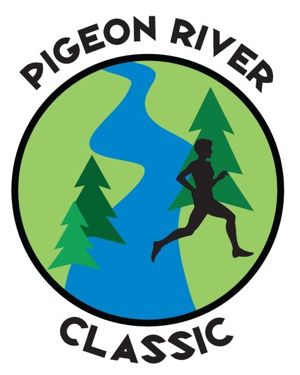A spontaneous trip to Grand Island, Michigan

KAYAKING
BY POLLY SCOTLAND
Lake Superior’s Pictured Rock National Lakeshore has 40 colorful miles of shoreline from Munising to Grand Marais, Michigan.
At the visitor center, we asked the perky young woman, “How do we get camping permits?”
The woman smiled sweetly and replied, “It’s July. Every site has been reserved for weeks.”
My husband Lee asked, “Is anything available on Grand Island?”
“That’s in the Hiawatha National Forest––not my district,” she replies “I’m with the National Park Service. You’d have to check their website.”
Lee whispers to me, “So much for spontaneity.”
I inquired to the woman, “How do I do that?”
The ranger said, “You have to set up an account at recreation.gov … then you can reserve any available site.”
Dreading the thought of creating another password, I managed to set up an account and randomly reserve sites at Driftwood and Gull Point.
It was noon when we arrived at Munising (Ojibwa for a place of the great island), then prepared to launch from the ferry dock on Powell Point.
After our kayak was loaded with gear and food for a three-day trip, we paddled the half-mile toward Grand Island for a 27-mile circumnavigation of her shores.
The island is shaped like a miniature Africa, with a smaller island, referred to as the Thumb, attached to the southeast corner by a sandbar called a tombolo.
A blue sky streaked with wispy clouds, light winds and 87-degrees made this a perfect day. The channel was busy with recreational boaters, jet-skis, scuba divers and cruise ships offering tours of the eight shipwrecks within the Alger Underwater Preserve.
As we kayaked across the channel’s crystal water, I thought about the history of the island before me. I imagined what life must have been like for the native people who seasonally fished, farmed and hunted here 5,000 years ago. In 1886, a fur trading post was established with the Ojibwa people.
In 1901, William Mather created the Grand Island Forest and Game Preserve. Even though Mather was a miner and owned the Cleveland-Cliffs Iron Company, he valued renewal and the preservation of nature. Sadly upon Mather’s death in 1951, 80 percent of the trees he tried to protect were logged.
In 1990, the Hiawatha Forest Service bought the island from the Cleveland Mining Company, thus restoring Mather’s dream of a natural environment.
We paddled over the submerged schooner Bermuda, which succumbed to the gales off the coast of Grand Marais in 1870. She was dredged up in 1883 and hauled to Munising where she escaped her lines, re-sank and now lies in 12 to 30-feet in the protected waters of Murray Bay near Grand Island.
After rounding Wick Point, we passed the dilapidated East Channel lighthouse, which operated from 1868 to 1913 and can only be seen from the water.
Kayaking offers a close-up inspection of the red sandstone cliffs, the weeping grottos and numerous ribbon-thin waterfalls––where getting a gentle shower is possible. Carved-out earthy-smelling caves beg to be paddled into.
The water, with temperatures rarely climbing above 55 degrees, ranges in 50 shades of green––from emerald, to aquamarine and then lapped by jade over a floor of chocolate-brown and bronze rock.
Lost in the reverie of exploration, the sound of far-off rumbles caused us to head toward our evening’s campsite at Driftwood. Before turning west into Trout Bay, we passed near the shipwrecks of Smith Moore, Manhattan, and the Herman H Hettler––but there is no time to investigate them.
As the sky darkened, we focused on getting to shore. When the kayak scraped sand, we pulled it out of the water, grabbed the tarp and found four white pine or hemlock trees in the dense forest to tie the tarp. We got the tent erect, the gear inside and out of our wetsuits into dry clothes. We also made sure to put on the necessary head net, as the mosquitoes and black flies can be quite the nuisance.
While I gathered up the food and wine, Lee secured the kayak hatches and cockpit in time to dash under the tarp as the heavens open.
I handed Lee a glass of wine––a toast for beating the rain. Smug in our narrow escape, we watched the water pour over the sides of the tarp. We are startled when one of its corners comes loose, drenching our cook bench and dried wood.
Lee re-secured the rope, placed the kayak paddle under the tarp’s sagging ceiling and we stood there, with wine-filled coffee mugs, for over an hour. After one final shuddering 30-second thunder roll, the rain stopped.
We checked out a muddy pathway where some 500 runners will descend next weekend for the Grand Island Marathon. We wandered along a path leading to a handicap-accessible boardwalk used by day visitors that get bussed around.
We carried an armful of dry firewood supplied by the forest service back to our campsite. Once Lee got the coals glowing in the fire pit, he cooked baked potatoes, brats and corn-on-the-cob.
After dinner, we walked the 1.5-mile sandy beach bordered by sand dunes and marshy swales. On our return trip, we saw three young boys laugh as they dug in the sand and splash in the lake while their mother got water boiling for their freeze-dried dinner.
I said to the mother, “You’re a brave one to be here with your three sons.”
She replied, “I’m Norwegian and this is what we always did when I grew up. By the way, I have five sons.”
I asked, “Did you take the ferry over? It’s great to see your boys unplugged from computers and enjoying nature.”
“Yes,” she said. “We’re staying two nights and hiking the 20-mile loop trail.”
Lee and I finished the beach walk before heading to bed. The peaceful sound of lapping waves lulled me to sleep.
In the morning, the trill of a solitary bird woke me. Lee handed me a cup of java as I sat on a wood stump. I slurped my coffee, testing its temperature and admired the calm lake. Rain droplets glistened on the tall grass illuminating a spider’s delicate web.
Since it was only 8 miles to our second night’s campsite at Gull Point, we leisurely finished our exploration of the east side of the island. There are more 100 to 200-foot limestone bluffs, with waterfalls cascading like the delicate strings of a harp. Over my right shoulder, the seascape of Pictured Rocks stretches for miles to the east.
As we listened to the glug-glug sound of waves bouncing back from a cave, a baby-faced solo kayaker rounded the bend. Drew is a 25-year-old guide finishing his third season at Pictured Rocks.
I told Drew that Grand Island was “Plan B” for us and he said, “Be happy you’re here. On a sunny day like today, the national lakeshore is a zoo.”
“Where did you camp last night?” I asked.
“The storm forced me into North Beach,” he quipped. “It was scary as hell! I heard the thunder and saw the lightning, but I didn’t get any rain––only high winds.”
We parted ways and continued paddling, scaring up great blue heron and a flush of mergansers. After we rounded Northeast Point, the Pictured Rocks mainland was no longer visible.
The mile-long sand of North Beach is inviting, so we broke for lunch where the North Light Creek flows into the lake.
A couple of mountain bikers rode out of the forest to the lake’s edge. We followed their tracks inland and discovered a new steel bridge replacing the eroded concrete bridge built by the Cleveland Cliffs Iron Company during the heyday of resorts.
Six giggling girls and two women jumped off a pontoon boat and waded in the warm waters of the creek, tossing a ball to their exuberant dog. Lee and I stroll over to the boat driver and strike up a conversation.
The man proudly said, “These are six of my eight grandchildren, my daughter and my wife. The kids are up from Illinois for their annual summer visit to our lake home.”
I politely inquired, “I thought the island was under the jurisdiction of the Hiawatha National Forest?”
He chuckled, “It is, but in 1990 we were one of about 20 cabins that were grandfathered in. The island still holds its charm after all these years.”
He also mentioned that his daughter was to run in the upcoming marathon around the island.
Lee and I left, paddling to North Point’s magnificent sea cave. We paddled under, around and through the cave on a day without the clapotis waves––the ones where incoming and outgoing waves intersect to create a huge splash. The noise inside the cave sounded like rhythmic garbage cans’ metal lids smacking.
We were too close to shore to see the Old North Light, the 1856 lighthouse perched 175-feet overhead on the towering cliffs just west of the sea cave.
Lee said, “Gull Point should be up ahead, just around Preservation Point.” After two miles he muttered, “Something’s wrong with my map reading skills. We should have been there by now.”
When we arrived at Mather Beach, we realized that Gull Point, like Old North Light, is 200 feet above the lake––impossible to reach by water. Lee tells me there are three camps listed here––Game Fence, Hemlock and Hardwood. After he returned from looking around, he reported that all the sites were taken.
Waterfall Beach was so crowded we didn’t bother to stop. Further down the shore is Juniper Flats, but it’s 6 feet off the water and not kayak friendly. When our final chance to camp at Merchandise Beach proved futile, we had no choice except to cross back to the mainland, load up the kayak and head to a motel in Marquette, Michigan.
We were disappointed not to spend one more perfect summer night on the island.
If we could have stayed two nights on the island, our trip could have been a Monumental Grand Island experience. Instead, we had to settle for a “grand” Grand Island adventure––so much for spontaneity.



